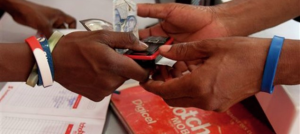This morning I spoke at USAID’s MiniU on Global Health at George Washington University with Charley Johnson of the USAID Mobile Solutions Office, Dustin Gibson of Johns Hopkins, and Pamela Riley of Abt Associates. The pearl?
1.7 billion people with access to a mobile phone have no bank account. 1 billion phone owners lack access to health care. Game on: mobile + money = better health.
The goal of the talk was to describe why I believe that mobile money will have a powerful impact on public health, from the perspective of my work at MEDA, where I support the organization in leveraging mobile across our 6 areas of focus – Savings, Youth, Rural Finance, Woman, Agriculture, and Health – to make each area more efficient & effective in creating Business Solutions to Poverty.
Narrowing in on how mobile money can improve post-disaster resilience, I focused on Haiti, where a recent evaluation of non-conditional cash transfers after the earthquake found that mothers who received cash spent it on food, refrigeration, cooking, and health services, and therefore (we assume) were able to better stabilize the health and nutrition of their families. However, this cash aid was rare and slow – after the earthquake, there simple was no way to move cash around the country due the lack of banking and transportation infrastructure, and Haitians were largely unable to receive either cash aid or remittances from family members abroad.
Understanding that the inability to transport cash around the country was one of the key hindrances to humanitarian relief efforts after the earthquake, the Gates Foundation and USAID turned to mobile money to ensure that these problems can be avoided in the future. The resulting incentive grant, the Haiti Mobile Money Initiative (HMMI) resulted in two mobile money products, T-Cash and TchoTcho Mobile. The question now is, has it worked?
The good news is, yes, at least, it’s starting to. The clearest example is the from only last month, when Hurricane Isaac made landfall near Port-au-Prince, where over 400,000 people still live in tents. Digicel was able to send cash aid to 5000 mothers within 2 days of the hurricane, an unprecedented response time for distribution of cash aid, since the mobile money transfer via TchoTcho Mobile reduced the time and infrastructure needed to distribute cash. We can assume that these mothers, like those after the earthquake, used this cash to maintain the nutrition and health of their families while rebuilding their homes yet again. There are several other organizations using TchoTcho Mobile to a variety of humanitarian and development projects.
Moving from mobile transfers in post-disaster relief, I covered a different end of the mobile money spectrum: supply-chain management. MEDA has been working with the government of Tanzania since 2004 to prevent malaria infection through the distribution of Long Lasting Insecticidal-treated Nets (LLINs) through the Tanzania Net Voucher System, or TNVS.
The program uses vouchers to provide a sustainable and convenient way to partially subsidize the cost of the voucher to women, while still encouraging the habit of paying for bed nets, which increases the likelihood that bed nets will actually be used. Last year, TNVS switched from a paper voucher system to an e-voucher system, so that now beneficiaries receive the voucher to their mobile phone, and all transactions are monitored electronically. In less than a year of implementation, the program has seen 3 key impacts:
- An estimated 30% savings in operation costs
- It is now possible to manage liability by having vouchers automatically expire after 60 days
- It is now possible to have real-time insight to the gaps in the supply chain, i.e. lack of demand for nets in certain areas or lack of supply in other areas, issues which keep vouchers from being redeemed. With the paper system, if a voucher wasn’t redeemed, there was no way to tell if the reason was on the supply or the demand side.
These are only two of many examples of how mobile money can improve public health. Other points that I appreciated from other panelists and audience members:
- The health sector is also a crucial way to promote the uptake of mobile money due to the size ot the sector in most countries.
- If health practitioners choose to design a program and need support from the mobile money operator, they need to sell the program based on the operator’s bottom line.
- In Kenya, the pilot run by John Hopkins and panelist Dustin Gibson to test using mobile money to incentivize vaccine uptake found that moms like mobile money more than airtime (in Kenya, where MPesa is ubiquitous) and that is important to involve husbands in order to increase uptake.
Where do you think the greatest potential is for mobile money to improve public health?
